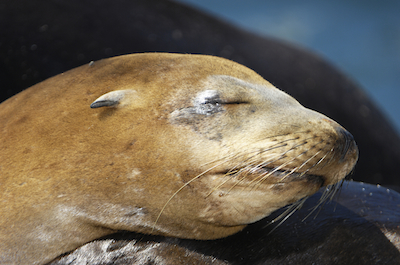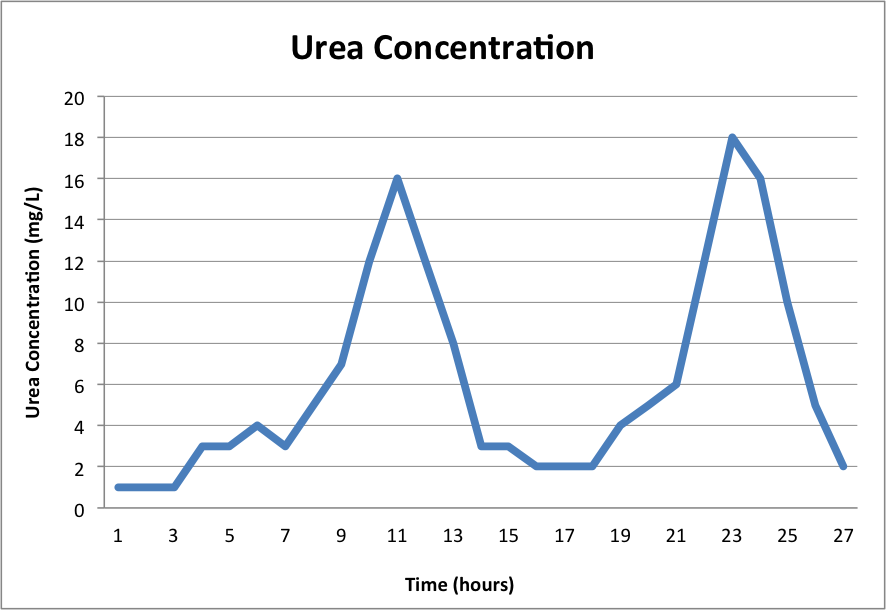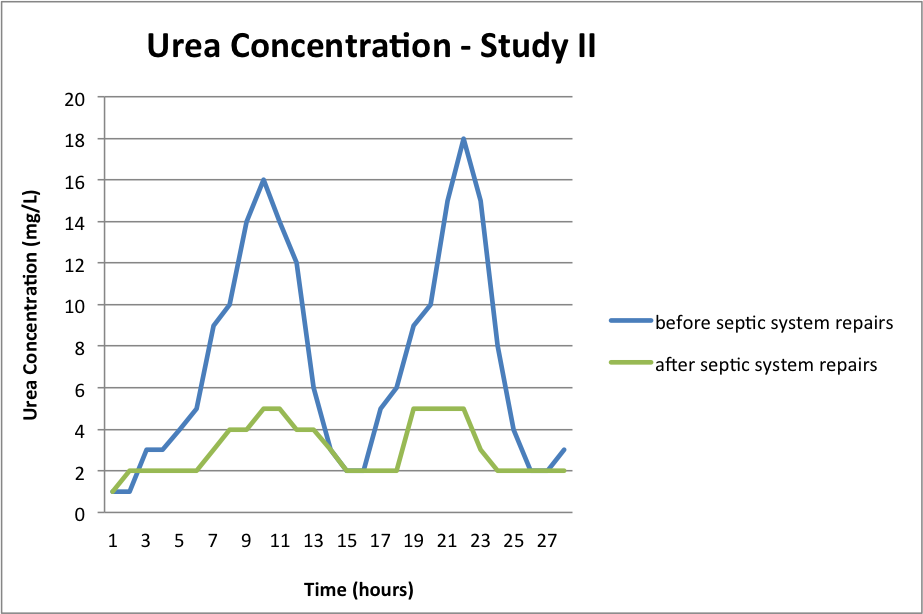
Chapter 15. Domoic Acid Is Maddening
Domoic Acid Is Maddening

Read the article below. Then answer the questions that follow.

In the wee hours of August 18, 1961, the coastal village of Capitola, California, was shaken out of slumber by the sound of thousands of birds violently crashing into windows, rooftops, and parked cars, en masse. In the foggy pre-dawn hours, inquisitive residents used flashlights to survey the situation only to be dive-bombed by addled birds, drawn to the glow of the flashlights. When morning broke, the avian onslaught had ceased. But residents were left with a disturbing scene: thousands of birds lay dead or dying in the streets.
If this sounds like a movie plot, you’re not far off. Film director and nearby resident Alfred Hitchcock used the eerie event as inspiration for his 1963 horror flick, The Birds, in which birds suddenly attack the citizenry of a coastal village.
What could cause the birds to behave so unusually? We now believe that a toxin called domoic acid might be responsible. However, researchers can’t say for sure that the toxin was to blame since domoic acid had not yet been identified at the time of the event. Yet marine biologists have since diagnosed thousands of similarly “crazed” marine animals with domoic acid poisoning, which is characterized by disorientation, brain damage, and—if untreated—death.
In recent history, domoic acid has been a major cause of sea animal fatality along California’s central coast. Along with birds, hundreds of sea otters and California sea lions fall victim to domoic acid poisoning each year.
A crazy discovery
The refrigerator in Dr. Raphael Kudela’s lab is filled with murky beakers of Pseudo-nitzschia australis, an ocean algae that blooms in Europe, North America, and even Antarctica when conditions are right. Although typically benign, Pseudo-nitzschia has been known to produce domoic acid.

Kudela has studied toxic algal blooms at the University of California, Santa Cruz, for more than a decade. He and others have spent years trying to identify the chemical that triggers domoic acid production. Now, studies show that the mystery culprit may be urea, a nitrogen-rich metabolic waste product present in mammalian urine (and thus home septic systems). Urea also can be manufactured and is commonly found in commercial lawn fertilizers.
Initially, Kudela was skeptical that urea could play such an important role in promoting toxic blooms. For one, it stands to reason that the volume of algae-facilitating pollutants like nitrates and phosphates that leach from sewage treatment plants and industrial farming operations would outweigh quantities of urea that might seep from homeowners’ septic tanks or lawns. Furthermore, upwellings—the movement of deep water to shallower depths—in Northern California’s coastal waters recycle nutrients quickly, suggesting that pollutants would be rapidly diluted, especially those present in low concentrations.
However, Kudela and his team were surprised to find an abundance of urea in the coastal waters where Pseudo-nitzschia blooms. Back in the lab, the scientists experimented with adding urea to beakers of Pseudo-nitzschia. When urea was added to beakers that also contained nitrates and ammonium, the algae resultantly increased production of domoic acid. In cases when the algae mysteriously began making low levels of domoic acid in clean water, the addition of urea nearly doubled toxin production.
Kudela has theorized that urea may be washing to sea from leaky septic tanks. Marine animals do not release enough urea to cause a problem. Likewise, sewage treatment plants in the area all tested clean.
“We still can’t say for sure where the urea is coming from, but it’s likely that humans are the problem,” says Kudela.
Even though researchers now know that urea is the likely offender, the toxic blooms continue to cause trouble. Urea and the other nutrients that cause eutrophication—the process in which excess nutrients dissolved in water lead to rapid growth of bacteria and algae—will continue to flow from yards and septic tanks to the ocean.
© 2015 WH Freeman and Company.
15.1 Comprehension Questions
Answer the following questions to demonstrate your understanding of the article.
1.
True/False:
Alfred Hitchcock’s 1963 horror film The Birds, where birds suddenly attack a coastal village, was based on true events.
2.
Excess nutrients dissolved in water may lead to rapid growth of bacteria and algae. This process is known as .
3.
According to research conducted by Dr. Raphael Kudela, ______ may be the chemical that triggers the production of domoic acid.
| A. |
| B. |
| C. |
| D. |
| E. |
4.
True/False:
Domoic acid is found in commercial lawn fertilizers and seepage from home septic systems.
5.
In the lab, Dr. Kudela and his team discovered that:
| A. |
| B. |
| C. |
| D. |
| E. |
6.
Why can’t scientists say for sure that domoic acid was to blame for the 1961 bird stranding incident in Capitola, California?
| A. |
| B. |
| C. |
| D. |
| E. |
7.
Which of the following is the most plausible reason why the 1961 bird stranding incident happened along the coast rather than an inland area where there is not a body of water?
| A. |
| B. |
| C. |
| D. |
| E. |
The line graph below represents urea concentration in milligrams per liter of water (mg/L) in samples taken off the coast of Northern California, 100 meters from an area where 25 homes line the coast. Each home has its own septic system. During the sampling period, high tide occurred at hour 11 and hour 23, and low tide occurred at hour 2 and hour 17. Answer the following question by referring to the graph. (Note: You may click the graph and expand it for a closer look.)

8.
Assuming that septic systems of the homes along the coast are the only sources of urea, which statement is the most correct about the relationship between tides and urea concentration?
| A. |
| B. |
| C. |
| D. |
| E. |
The following graph displays the results of two, separate rounds of urea sampling off the coast of Northern California, 100 meters from an area where 25 homes line the coast. Each home has its own septic system. The first round of sampling was taken prior to the inspection and repair of the homes’ septic systems. The second round of sampling was taken after inspection and repair of the septic systems. During both sampling periods, high tide occurred at hour 10 and hour 22, and low tide occurred at hours 2, 15, and 27. Refer to the graphed data below to answer the following question. (Note: You may click on the graph and expand it for a closer look.)

9.
Which of the following statements reflects a correct interpretation of the observed results?
| A. |
| B. |
| C. |
| D. |
| E. |
10.
A group of small mammals, whose main food source is fish from a rural lake, have begun to exhibit symptoms of domoic acid poisoning, including erratic behavior and death. Testing has revealed very low levels of domoic acid in their tissues, but wildlife biologists believe additional testing is warranted. The biologists capture two-dozen of these small mammals and set up an experiment to test their response to low levels of domoic acid. Based on that information, complete the paragraph below.
The experiment is set up with two groups. The first group is the experimental group, which you would give each day. The second group, our control group, would be given each day.
The head biologist on the research team wonders if domoic acid is causing these small mammals to act erratically and die. This would be considered a testable . The ultimate goal of the experiment is to disprove that domoic acid has absolutely no effect on these mammals. Essentially, this is the .
This is a correctly designed experiment because we are only testing variable(s) between the two groups.
Activity results are being submitted...